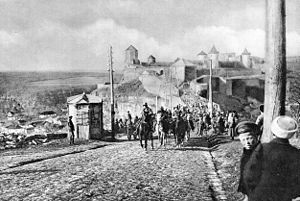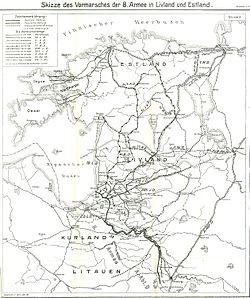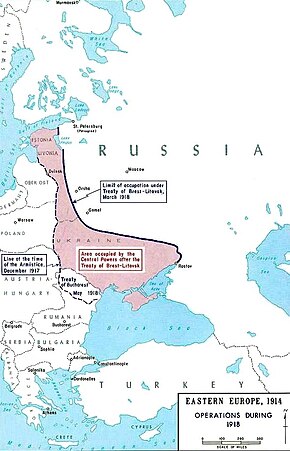
The Russian Civil War was a multi-party civil war in the former Russian Empire sparked by the overthrowing of the social-democratic Russian Provisional Government in the October Revolution, as many factions vied to determine Russia's political future. It resulted in the formation of the Russian Socialist Federative Soviet Republic and later the Soviet Union in most of its territory. Its finale marked the end of the Russian Revolution, which was one of the key events of the 20th century.

The Treaty of Brest-Litovsk was a separate peace treaty signed on 3 March 1918 between Soviet Russia and the Central Powers, by which Russia withdrew from World War I. The treaty, which followed months of negotiations after the armistice on the Eastern Front in December 1917, was signed at Brest-Litovsk.

The Declaration of the Rights of the Peoples of Russia was a document promulgated by the Bolshevik government of Russia on 15 November 1917 and signed by Vladimir Lenin and Joseph Stalin.

The Soviet westward offensive of 1918–1919 was part of the campaign by Soviet Russia into areas abandoned by the Ober Ost garrisons that were being withdrawn to Germany following that country's defeat in World War I. The initially successful offensive against the Republic of Estonia ignited the Estonian War of Independence which ended with the Soviet recognition of Estonia. Similarly, the campaigns against the Republic of Latvia and Republic of Lithuania ultimately failed, resulting in the Latvian–Soviet Peace Treaty and Soviet–Lithuanian Peace Treaty respectively. In Belarus, the Belarusian People's Republic was conquered and the Socialist Soviet Republic of Byelorussia proclaimed.

The Allied intervention in the Russian Civil War consisted of a series of multi-national military expeditions that began in 1918. The initial impetus behind the interventions was to secure munitions and supply depots from falling into the German Empire's hands, particularly after the Bolsheviks signed the Treaty of Brest-Litovsk, and to rescue the Allied forces that had become trapped within Russia after the 1917 October Revolution. After the Armistice of 11 November 1918, the Allied plan changed to helping the White forces in the Russian Civil War. After the Whites collapsed, the Allies withdrew their forces from Russia by 1925.

The Left SR uprising, or Left SR revolt, was a rebellion against the Bolsheviks by the Left Socialist Revolutionary Party in Moscow, Soviet Russia, on 6–7 July 1918. It was one of a number of left-wing uprisings against the Bolsheviks that took place during the Russian Civil War.

The Russian Civil War spread to the east in May 1918, with a series of revolts along the route of the Trans-Siberian Railway, on the part of the Czechoslovak Legion and officers of the Russian Army. Provisional anti-Bolshevik local governments were formed in many parts of Siberia and other eastern regions during that summer. The Red Army mounted a counter-offensive in the autumn of 1918. Throughout the winter and spring of 1918/1919, the White Army had dominance over this front. In the summer of 1919, and from then onwards, the Red Army defeated the White commander Aleksandr Kolchak. The White Army collapsed in the East as well as on other fronts throughout the winter of 1919/1920. Smaller-scale conflicts in the region went on until as late as 1923.

Various factions fought over Ukrainian territory after the collapse of the Russian Empire following the Russian Revolution of 1917 and after the First World War ended in 1918, resulting in the collapse of Austria-Hungary, which had ruled Ukrainian Galicia. The crumbling of the empires had a great effect on the Ukrainian nationalist movement, and in a short period of four years a number of Ukrainian governments sprang up. This period was characterized by optimism and by nation-building, as well as by chaos and civil war. Matters stabilized somewhat in 1921 with the territory of modern-day Ukraine divided between Soviet Ukraine and Poland, and with small ethnic-Ukrainian regions belonging to Czechoslovakia and to Romania.

The Odessa Soviet Republic was a short-lived Soviet republic formed on 30 January [O.S. 17 January] 1918 from parts of the Kherson and Bessarabia Governorates of the former Russian Empire.

The Ukrainian War of Independence, also referred to as the Ukrainian–Soviet War in Ukraine, lasted from March 1917 to November 1921. It saw the establishment and development of an independent Ukrainian republic, most of which was absorbed into the Soviet Union as the Ukrainian Soviet Socialist Republic of 1922–1991.

The Treaty of Brest-Litovsk was signed on 9 February 1918 between the Ukrainian People's Republic (UPR) and the Central Powers, ending Ukraine's involvement in World War I and recognizing the UPR's sovereignty. The treaty, which followed the armistice on the Eastern Front in December 1917, was signed at Brest-Litovsk. The peace delegation from Soviet Russia, led by Leon Trotsky, did not recognize the UPR delegation, which had been sent from the Central Rada in Kiev, instead recognizing a delegation from the Ukrainian People's Republic of Soviets in Kharkov.

Estonia was under military occupation by the German Empire during the later stages of the First World War. On 11–21 October 1917, the Imperial German Army occupied the West Estonian archipelago, including the larger islands of Saaremaa (Ösel), Hiiumaa (Dagö), and Muhu (Moon).

The Ukrainian People's Republic (UPR) was a short-lived state in Eastern Europe. Prior to its proclamation, the Central Council of Ukraine was elected in March 1917 as a result of the February Revolution, and in June, it declared Ukrainian autonomy within Russia. Its autonomy was later recognized by the Russian Provisional Government. Following the October Revolution, the Central Council of Ukraine denounced the Bolshevik seizure of power and proclaimed the Ukrainian People's Republic with a territory including the area of approximately eight Russian imperial governorates. It formally declared its independence from Russia on 22 January 1918.
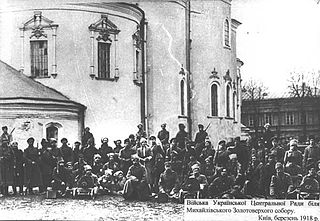
The Ukrainian–Soviet War is the term commonly used in post-Soviet Ukraine for the events taking place between 1917–21, nowadays regarded essentially as a war between the Ukrainian People's Republic and the Bolsheviks. The war ensued soon after the October Revolution when Lenin dispatched Antonov's expeditionary group to Ukraine and Southern Russia.

On 15 December [O.S. 2 December] 1917, an armistice was signed between the Russian Soviet Federative Socialist Republic on the one side and the Austro-Hungarian Empire, the Kingdom of Bulgaria, the German Empire and the Ottoman Empire—the Central Powers—on the other. The armistice took effect two days later, on 17 December [O.S. 4 December]. By this agreement Russia de facto exited World War I, although fighting would briefly resume before the Treaty of Brest-Litovsk was signed on 3 March 1918, and Russia made peace.
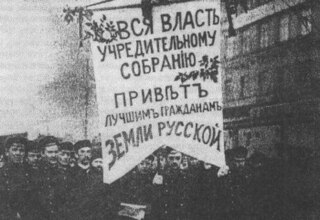
Events from the year 1918 in Russia
This article covers the timeline of the Estonian War of Independence (1918−1920) and a few key events in the prelude and aftermath of the war.
Operation Schlußstein was a German military operation, which was carried out towards the end of the First World War in the Baltic Sea region and in Karelia with the aim of occupying the Murman Railway.
Central Powers intervention in the Russian Civil War consisted of a series of multi-national military expeditions starting in 1918. This intervention was picking up from the Eastern Front against the newly set up Russian Republic. The main goals of the intervention were to maintain the territories received in the Treaty of Brest-Litovsk, prevent a re-establishment of the Eastern Front, and administer new conquered territories. After the defeat of the Central Powers, many armies that stayed mostly helped the Russian White Guard eradicate communists in the Baltics until their eventual withdrawal and defeat. In addition, pro-German factions fought against the newly independent Baltic states until their defeat by the Baltic States, backed by the victorious Allies.
The Treaty of Berlin of August 27, 1918 was an agreement signed after several months of negotiations between Bolshevik representatives and the Central Powers, mainly represented by the Germans. This treaty completed and clarified the political and economic clauses of the Treaty of Brest-Litovsk, which had been left out of the winter 1917-1918 negotiations. The latter were aimed at ending the war between the Central Powers and Russia and clarifying the extent of Russia's territorial losses, but left unresolved the question of war indemnities due to the Imperial Reich and its allies. Similarly, the nature of the new economic relations between the Central Powers and Russia was not discussed in depth at Brest-Litovsk. Consequently, in accordance with the terms of the peace treaty signed in early 1918, negotiations should regulate future economic relations between the Central Powers and Bolshevik Russia, and lead to the conclusion of an agreement between the Reich and its allies, on the one hand, and Russia, on the other. However, due to the rapid development of the conflict during September and October 1918, the provisions contained in the text of this treaty never came into force. Nevertheless, this agreement laid the foundations for the Treaty of Rapallo between the Reich and Bolshevik Russia, which came into force in 1922.
